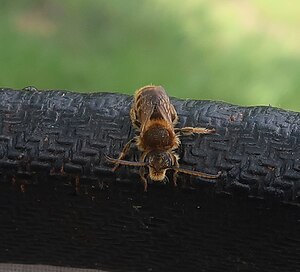Slipper bees
| Slipper bees | ||||||||||||
|---|---|---|---|---|---|---|---|---|---|---|---|---|

Male slipperbees of the species Rophites algirus on the edge of the net |
||||||||||||
| Systematics | ||||||||||||
|
||||||||||||
| Scientific name | ||||||||||||
| Rophites | ||||||||||||
| Spinola , 1808 |
The slurp bees ( Rophites ) are a genus from the family Halictidae within the bees . 14 species of them are known, 12 of which are also found in Europe , two in Central Europe and one more in Austria, Rophites hartmanni . The genus is spread across the Palearctic and is closely related to the glossy bees ( Dufourea ).
features
The bees reach a body length of 7 to 10 millimeters and have a brown-black body color. The thorax is hairy yellowish to light brown. The Tergites the abdomen have, as in the furrows bees ( Halictus ) on narrow light bonding at the trailing edge, the longitudinal groove on the last Tergit lacks the bright coloring. The females have a hairy thorn on their foreheads, which makes it easier to collect pollen in the small flowers of the mint family . The short feelers of the drones are colored orange-brown on the underside. Drones also have gray-brown hair on the abdomen and a narrow anal plate that protrudes over the edge of the last tergite.
Way of life
Slurp bees are oligolectic and only collect pollen from mint plants (Lamiaceae), such as ziesten ( Stachys ) and black nettles ( Ballota ). They press their hair sticks against the anthers of the flowers in order to get to the pollen and then brush it out with their front legs to attach it with the middle pairs of legs to the hairbrushes of the rear rails and the cups on the underside of the hind legs. The drones fly around looking for females on the traditional plants and often also spend the night on its flowers.
The animals fly in one generation from June to August and each nest solitary in small communities on areas with little or no vegetation. The nests are created vertically at a depth of 15 to 25 centimeters, with one to three horizontal brood cells next to each other at the end of 5 to 15 millimeter long side aisles that branch off at right angles to the main passage. The side aisles are filled up again after the brood cells have closed. The larvae pupate in a cocoon and hibernate. The slurp bees are parasitized by cuckoo bees from the genus of power bees ( Biastes ). Since they are only very rare, their parasites are also at risk.
Species (Europe)
- Rophites algirus Perez, 1895
- Rophites canus Eversmann, 1852
- Rophites caucasicus Morley, 1876
- Rophites clypealis Schwammberger, 1976
- Rophites epiroticus (Schwammberger, 1975)
- Rophites foveolatus friezes, 1900
- Rophites graeca (Ebmer, 1976)
- Rophites hartmanni Friese, 1902
- Rophites hellenicus Ebmer, 1984
- Rophites quinquespinosus Spinola, 1808
- Rophites styx (Ebmer, 1976)
- Rophites thracius Ebmer, 1993
- Rophites trispinosus Schummel, 1829